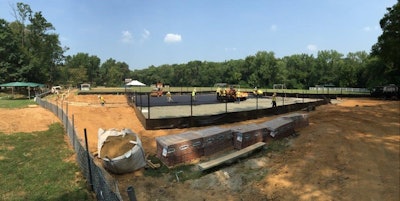
Recreational paving is a very specialized field that requires experience and a level of precision not typically seen on your everyday paving jobs.
“The paving of tennis courts, sports courts, and running tracks is what we call the plastic surgery of paving,” says Erick Finley, owner of Finley Asphalt. “The smoothness tolerance is typically ¼” when checked with a 10’ straight edge, and of course no standing water. The goal is to have the asphalt surface as flat as possible with just enough slope to drain the water off. Typically most parking lots are designed with 1.5% to 2% slope. Sports surfaces range from .83% to 1%.”
The team at Finley Asphalt and Sealing, based out of Manassas, VA went in to the construction of a multi-use court with those goals in mind. The Congressional School of Virginia did not have any courts on their campus and had selected the new court to be built on the site baseball field that had fallen into disrepair.
The work was to be performed during multiple summer camps (800+ children in attendance) and the location of the site was at a low spot on the property, which meant the Finley team could only work on dry days.
“To overcome these challenges, we were in constant communication with the client to ensure that our work did not interfere with any of the summer activities and that work being completed was done in a safe and efficient manner,” Finley says. “We dealt directly with Chris Pryor who holds the position of Director of Advancement at the School. My son Jonathon also helped coordinate with the school while on summer break from college.”
With this being a school, Finley had to complete all the work before school began. Originally the project was planned to start just after school let out in mid-June. However due to permitting delays the project could not start till August 10th.
“The completion date and summer activities created a very strict timetable for completion which required us to complete large portions of the work over some weekends,” Finley says.
A Porous Predicament
With any sports surface, there can obviously be no standing water. The client chose porous asphalt to be installed to eliminate the need for additional storm water management systems. This presented both an opportunity and a challenge for Finley.
“The porous pavement installation brought additional challenges compared to traditional paving,” Finley says. “We had to install a unique drainage system under the court and cover that with 7” of 3” stone and a 2” layer of ¾” stone over top.
“The biggest challenge is laying the porous asphalt on ¾” drainage stone versus paving on a standard roadbase stone. It is basically like paving on marbles. For this project we kept the dump trucks off of the stone and utilized a Wacker Neuson Dumper with flotation tires that would not disturb the stone underneath to transport the asphalt to the paving machine. This way we did not rut the stone with the large dump trucks.”
The compaction efforts are also different than standard hot mix asphalt, Finley explains. “With porous pavement you basically roll it smooth and do not utilize the vibration on the rollers.”
Approximately 150 tons of friction course mix that is designed to allow water to drain through the asphalt was laid. Since porous asphalt is not available at every asphalt facility, Finley had to pick up the mix from a supplier that was 45 miles away. Finley says that weather was in their favor here as the work was performed in August and the mix temperatures were not an issue.
The Finley paving crew of 11 used a LeeBoy 8510 paver, Hamm HD-14 Roller, Wacker RD-11 Roller, and a Bobcat S650 skid steer loader to complete the majority of the work on this project.
“Recreational paving is a very specialized field,” Finley says. “The precision required in these projects can create completely different sets of challenges from standard paving and they really require a contractor with the experience and equipment to perform them.
“This project also showcases the use of porous asphalt. With the nationwide focus on storm-water impact on the environment and the continued increase of legislation by state and local government on the issue, porous pavement presents an excellent option to help comply with the new regulations.
We submitted this project to showcase another side of the paving industry and it is an honor to win this award and be recognized by our peers,” Finley concludes.





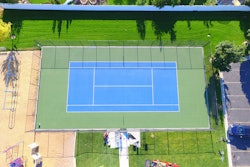
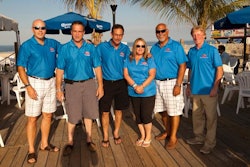
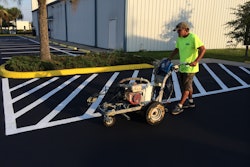


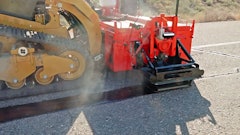

![Lee Boy Facility 2025 17 Use[16]](https://img.forconstructionpros.com/mindful/acbm/workspaces/default/uploads/2025/09/leeboy-facility-2025-17-use16.AbONDzEzbV.jpg?ar=16%3A9&auto=format%2Ccompress&fit=crop&h=135&q=70&w=240)








